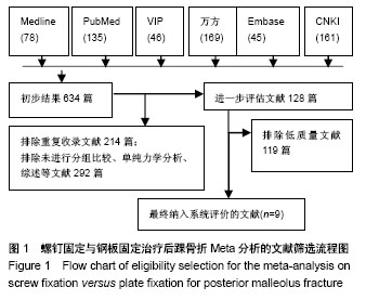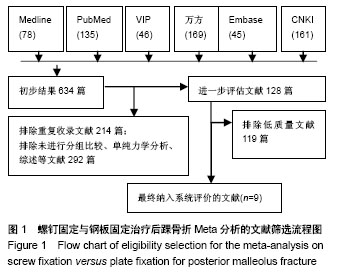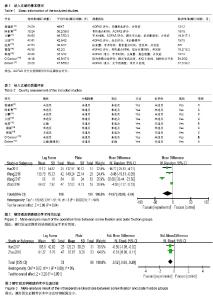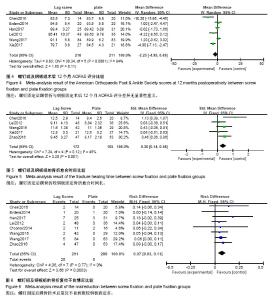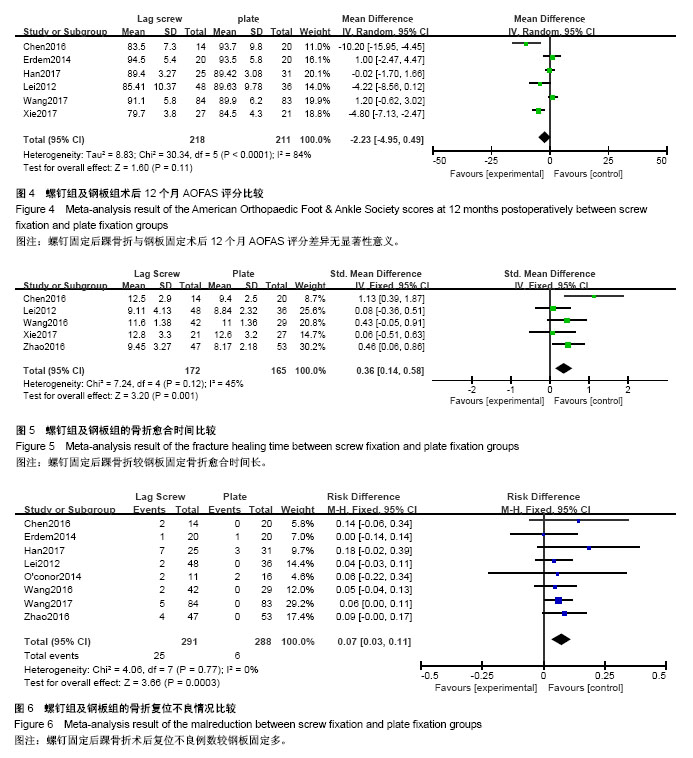| [1] Xu HL,Liu LM,Li X,et al. Multicenter follow-up study of ankle fracture surgery. Chin Med J. 2012;125(4):574-578.[2] Irwin TA, Lien J, Kadakia AR. Posterior malleolus fracture. J Am Acad Orthop Surg. 2013;21(1):32-40.[3] Fitzpartick DC,Otto JK,Mckinley TO,et al. Kinematic and contact stress analysis of posterior malleolus of the ankle. Orthop Trauma. 2004; 18(5):271-278. [4] McKinley TO, Rudert MJ, Koos DC, et al. Incongruity versus instability in the etiology of posttraumatic arthritis. Clin Orthop Relat Res. 2004; (423): 44-51.[5] 姜保国,张殿英,付中国,等.踝关节骨折的治疗建议[J]. 中华创伤骨科杂志, 2011,13(1):51-54.[6] Gardner MJ,Streubel PN,McCormick JJ,et al.Surgeon practices regarding operative treatment of posterior malleolus fractures. Foot Ankle Int. 2011;32(4):385-393.[7] Wang L,Shi ZM, Zhang CQ, et al. Trimalleolar fracture with involvement of the entire posterior plafond. Foot Ankle Int. 2011;32(8):774-781.[8] Juni P, Altman DG, Egger M. Assessing the quality of controlled clinical trials. BMJ. 2001;323(7303):42-46. [9] 谢建新,余建,邵强,等. 两种方法治疗伴后踝骨折的踝关节骨折疗效比较[J]. 临床骨科杂志,2017, 20(2):214-216. [10] 陈长青,王成,王耀生,等. 钢板与空心钉治疗 HaraguchiⅠ型后踝骨折的疗效比较[J]. 骨科,2016, 7(5):333-337. [11] 王鹏,张翔,沈云,等. 空心螺钉与支撑钢板治疗后踝骨折的比较研究[J].中华创伤骨科杂志,2017,19(3):192-197. [12] 王拯,张良,邱少东,等. 三种固定方式治疗后踝骨折效果比较[J].宁夏医科大学学报,2016,38(5):578-581. [13] 赵勇, 薛锋. 掌骨钢板和空心钉内固定治疗后踝骨折对比研究[J].临床误诊误治,2016, 29(5):98-101. [14] 雷磊,杨铁毅,王治,等. 空心钉与钢板治疗后踝骨折临床疗效对比分析[J].宁夏医科大学学报,2012, 34(8):783-785. [15] 韩晶,魏世,徐峰,等. 三种不同内固定方式治疗后踝骨折的对照研究[J].华南国防医学杂志,2017,31(2):108-111. [16] O?Connor TJ, Mueller B, Ly TV, et al. “A to P” screw versus posterolateral plate for posterior malleolus fixation in trimalleolar ankle fractures. J Orthop Trauma. 2015;29(4):151-156. [17] Erdem MN, Erken HY, Burc H, et al. Comparison of lag screw versus buttress plate fixation of posterior malleolar fractures. Foot Ankle Int. 2014;24(10):1022-1030. [18] Ramsey PL,Hamilton W. Changes in tibiotalar area of contact caused by lateral talar shift. J Bone Joint Surg. 1976;58(3): 356-357. [19] Macko VW,Matthews LS,Zwirkoski P,et al. The joint-contact area of the ankle. The contribution of the posterior malleolus. J Bone Joint Surg. 1991; 73(3): 347-351. [20] 赵宏谋,梁晓军,李毅,等. 后踝骨折复位程度对胫距关节接触情况的影响[J]. 中华创伤杂志,2014,30(10):1035-1039. [21] Abdelgawad AA,Kadous A,Kanlic E. Posterolateral approach for treatment of posterior malleolus fracture of the ankle. J Foot Ankle Surg. 2011;50(5):607-611.[22] Tejwani NC,Pahk B,Egol KA. Effect of posterior malleolus fracture on outcome after unstable ankle fracture. J Trauma. 2010;69(3):666. [23] 段小军,尹力,杨柳.后踝骨折手术治疗要点的研究进展[J].中华创伤骨科杂志,2015,17(4):1098-1101. [24] 李永舵,刘书茂,贾金生. 后踝骨折内固定方法的选择:生物力学及临床应用研究[J]. 北京大学学报(医学版), 2011,43(5):718-723. [25] 冯晓冰,罗轶,张龙. Haraguchi Ⅱ型后踝骨折两种内固定方式的生物力学研究[J]. 中国矫形外科杂志,2017, 25(12):1129-1133. [26] Bailón-Plaza A, van der Meulen MC. Beneficial effects of moderate, early loading and adverse effects of delayed or excessive loading on bone healing. J Biomech. 2003;36(8): 1069-1077.[27] Gardner MJ, van der Meulen MC, Demetrakopoulos D, et al. In vivo cyclic axial compression affects bone healing in the mouse tibia. J Orthop Res. 2006;24(8): 1679-1686. [28] 万全会. 后踝关节骨折不同内固定方式的生物力学性能对比[J]. 中国组织工程研究,2015,19(48): 7806-7810.[29] 彭义,曲家富,曹立海. 钢板与螺钉内固定对后踝关节骨折患者的疗效及IL-6、IL-8和 CRP的影响[J]. 中国临床研究, 2017, 30(6):816-818. |
